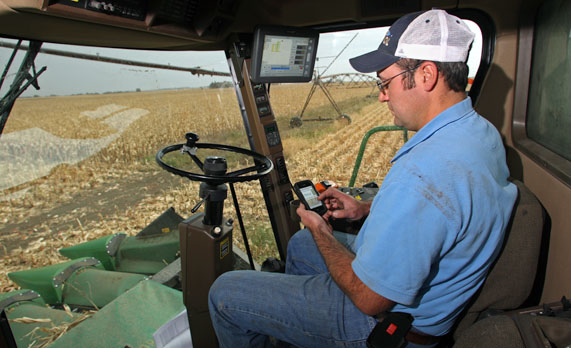Forged out of necessity and grounded in a tradition of service, iGrow.org has continued to increase in size since its inception in January 2011.

Keith Alverson ’02 uses his iPhone to check the iGrow website in the cab of his computer-equipped tractor last fall.
Legislative budget cuts that year resulted in a restructuring of SDSU Extension. When the dust settled, Extension had a new system of organization for its field specialists and 4-H advisers as well as a new website for sharing information.
Since it first came online, iGrow has lived up to its name, growing and evolving as a reliable source of research and information.
“We’re seeing meaningful, deep contacts with more than 40,000 people,†says Emery Tschetter, assistant director for marketing and accountability in the College of Agriculture and Biological Sciences. “People are coming, getting the information they want and coming back.â€
When iGrow was in its planning stages, one of the areas being researched was how farmers use technology. One of the findings was that the highest level producers, the ones who make a good living off agriculture, are the early adapters of technology.
“In that environment,†Tschetter says, “the Internet’s just another tool to them.â€
A favorite of tech-savvy farmers
It’s a tool that works for Keith Alverson ’02 who has a ridge till corn and soybean farm about 45 miles southwest of Brookings near Chester.
“I like the articles on the Agronomy page,†says Alverson, who accesses the site a few times a week using his computer and his iPhone. “The profit tips, business decisions, and agronomic reminders are helpful for issues that take place in and out of the crop growing season.â€
Alverson isn’t the only one accessing iGrow. Tschetter points to ever-growing numbers for the site, including 140,000 page hits and an average user time of three minutes and 29 seconds. He explains that users typically spend about a minute on institutional sites.
Always something fresh
Content is the key to driving website traffic. Information is offered under six main headings: 4-H and Youth, Livestock, Agronomy, Healthy Families, Community Development and Gardens. Key topic areas under those headings offer information about iGrow “communities†like Beef, Dairy, Soybeans, Wheat, Food and Nutrition and Families.
“We’ve almost doubled in size,†Tschetter says of the communities, noting that the site started with 10 and now has 18.
 The success of iGrow has been tied to providing reliable, fresh information. Tschetter notes that iGrow is on a pace to offer its users 40,000 articles per year.
The success of iGrow has been tied to providing reliable, fresh information. Tschetter notes that iGrow is on a pace to offer its users 40,000 articles per year.
“Every area has something fresh every week,†Tschetter says. “This is how Extension talks to people.â€
That’s all accomplished through new standards that were part of the reorganization of Extension. Each of Extension’s more than 40 field specialists devotes 20 percent of their time to providing information to iGrow.
“That’s one day of the week for everyone on staff,†Tschetter says. “We’re probably doing more than that.â€
New material goes up on the site five days a week. Tschetter expects the pace of new material to increase in the spring and summer.
“As we get into the growing season, articles will be much more current,†Tschetter says.
The website is making an impact through the one-day-a-week efforts of field specialists and just two other employees dedicated to iGrow. During the 2011 budget cuts, the College of Agriculture and Biological Sciences was forced to shut down its communications unit.
“We’re learning how to communicate without a communications office,†Tschetter says.
Radio, podcasts supplement iGrow
Part of that communications effort has succeeded through developing new partnerships. The Department of Journalism and Mass Communication is working with iGrow to create podcasts in the department’s new Yeager Media Center.
“We haven’t begun to scratch the surface of their capacity,†Tschetter says.
Extension has also launched the iGrow Radio Network consisting of 12 major radio stations across the state. From her home in Kimball, Pam Geppert ’86 produces daily, three-minute segments interviewing Extension personnel on a wide range of current topics.
Tschetter notes that through iGrow’s relationship with Mark Swendsen at KGFX in Pierre, Extension got the jump on tackling some central South Dakota issues.
“It’s a business relationship that helped us listen,†Tschetter says. “It’s an unexpected, positive relationship.â€
Apps, courses in the future
Just like everyone else with a site on the World Wide Web, Tschetter needs to look to the future to keep iGrow interesting and vibrant. One area under consideration is making Extension certification courses like food preparation and pesticide use available on the website.
“We have to ask ourselves, ‘How will we be teaching in the future?’†Tschetter says.
In the future, Tschetter sees an expansion in the site’s capacity for handling video and a redesign of the home page to accommodate more partnership and sponsorship links.
“We thought we were stretched,†Tschetter says of the site’s original design, “but we didn’t quite stretch enough.â€
In the near future, iGrow users will have access to applications that may be downloaded from the website.
Tschetter says one app allows a farmer to get a stand count in a cornfield, photograph the area and lock in the stand’s location using GPS. If a hailstorm comes along, the farmer can go to that exact location, photograph it and use the information to document a crop insurance claim.
“We’ll be giving people something brand new,†Tschetter says, “and the technology is probably right in their pocket on their smartphone.â€
Dana Hess






